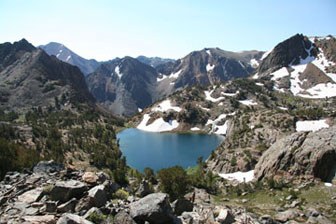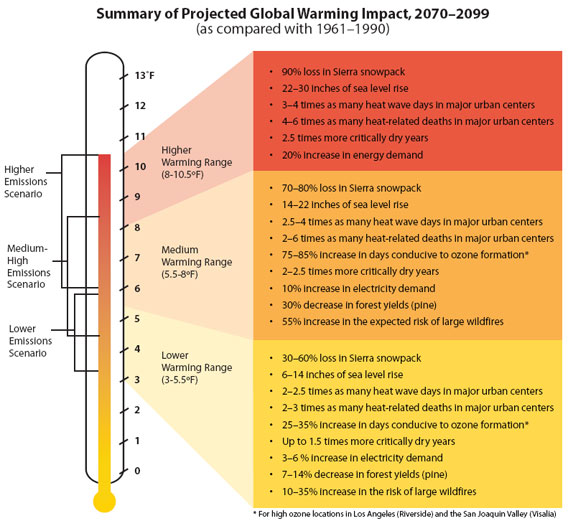Global Warming to Have Significant Impact on California
Global Warming to Have Significant Impact on California
mongabay.com
July 31, 2006
A new report from the state of California warns that climate change could have a significant impact on the state’s economy and the health of its residents. The release of the report comes on the day that British Prime Minister Tony Blair and California governor Arnold Schwarzenegger signed a climate pact agreeing to reduce greenhouse gas emissions.
The report, “Our Changing Climate: Assessing the Risks to California,” says that the state climate is expected to become considerably warmer before the end of the century, the degree to which depends on the rate at which humans continue to burn fossil fuels. It looks at three potential scenarios: lower warming range with projected temperature rises between 3 and 5.5°F, medium warming range with projected temperature rises between 5.5 and 8°F, and higher warming range with projected temperature rises between 8 and 10.5°F.
Changing Precipitation Patterns
“Our Changing Climate” says that the three projections show little change, on average, in total annual precipitation for the state but warns that even modest declines in precipitation levels “would have a significant impact because California ecosystems are conditioned to historical precipitation levels and water resources are nearly fully utilized.”
The report warns that while total precipitation is by affected much over the course of the century, rising temperatures may cause more precipitation to “fall as rain instead of snow, and the snow that does fall will melt earlier, reducing the Sierra Nevada spring snowpack by as much as 70 to 90 percent” increasing the risk of summer water shortages, reducing hydropower generation by as much as 30 percent, and diminishing skiing and other snow-related recreational activities. Rising sea levels could further damage the state’s water supplies by flooding groundwater aquifers and the Sacramento/San Joaquin River Delta.
 Eastern Sierra Nevada in California. Photo by Rhett A. Butler
Climate change increases California flood, drought risk Climate change may increase the risk of winter floods and summer water shortages—even within the same year—says new research by scientists Lawrence Livermore National Laboratory (LLNL). California plans to cut greenhouse gas emissions California plans to introduce legislation that will impose binding limiting on future greenhouse gas emissions. The state aims to cut current levels of emissions 10 percent by 2020, to bring pollution in line with 1990 levels. It would become the first state to implement mandatory controls on greenhouse gasses. California adopts massive solar energy project The California Public Utilities Commission approved a $2.9 billion program to make the state one of the world’s largest producers of solar power. The plan would add 3,000 megawatts of solar energy over 11 years through the installation of 1 million rooftop solar energy systems on homes, businesses, farms, schools and public buildings. The amount of electricity generated would be equivalent to about six new power stations. Solar power could save California utility customers an estimated $9 billion from a reduced need to build new power plants and purchase electricity supplies at peak demand. California to face water shortage warns new study At current rates, California’s demand for water will increase by 40 percent over the next 25 years, warns a new study from the Public Policy Institute of California. The nonprofit group projects that California will add fourteen million more people by 2030, each of whom will be using 232 gallons a day. Much of the water will be used for landscaping, especially in the drier interior areas where much of the state’s population growth is occuring. About half of all the water used by inland homeowners goes to irrigating yards, compared to one third or less on the cooler coast. |
To meet projected needs for freshwater resources in the face of a growing population and economy, the report says that California may need to build additional reservoirs for water supply and winter flood control.
Health Problems Expected
“Our Changing Climate” warns that the expected impact of global warming on public health is of even greater concern.
“Continued global warming will affect Californians’ health by exacerbating air pollution, intensifying heat waves, and expanding the range of infectious diseases,” reads the report. “Higher temperatures are expected to increase the frequency, duration, and intensity of conditions conducive to air pollution formation.”
The report says that health problems including asthma and other acute respiratory and cardiovascular diseases will likely worsen due to the effects of increased air pollution. Further, a projected increase in the number of wildfires could produce higher levels of fine particulate matter, contributing to still worse air quality. Heat waves will likely increase mortality from “dehydration, heat stroke/exhaustion, heart attack, stroke, and respiratory distress.”
Global Warming Impact on California Farmers
Beyond health, climate change will have a significant impact on the state’s $30 billion agriculture industry that employs more than one million workers.
“Increased heat-trapping emissions are expected to cause widespread changes to this industry, reducing the quantity and quality of agricultural products statewide,” the report says. “Although higher carbon dioxide levels can stimulate plant production and increase plant water-use efficiency, California farmers will face greater water demand for crops and a less reliable water supply as temperatures rise. Crop growth and development will change, as will the intensity and frequency
of pest and disease outbreaks. Rising temperatures will likely aggravate ozone pollution, which makes plants more susceptible to disease and pests and interferes with plant growth.”
“Our Changing Climate” says that higher temperatures may result in less-than-optimal development for many crops worsening the quantity and quality of yield for agricultural products like wine grapes, dairy products, and fruits and nuts. Milk production may fall by as much as 20 percent if temperatures rise to the higher warming range by the end of the century. The report warns that agricultural weeds and pests will likely thrive under warmer conditions, further damaging agricultural production.
Impact on Ecosystems and Coastal Regions
The report says that higher temperatures and shifts in precipitation could alter the state’s ecological communities, affecting biodiversity and reducing the productivity of commercial forests. The risk of large wildfires could rise by as much as 55 percent according to medium range forecasts. Ecosystems — estuaries and wetlands — providing important ecological services like flood control and water filtration could be degraded by higher sea levels.
Climate change is expected to worsen storm damage in coastal areas and along rivers. Sea levels are projected to 22 to 35 inches by the end of the century, threatening to “inundate coastal areas with salt water, accelerate coastal erosion, threaten vital levees and inland water systems, and disrupt
wetlands and natural habitats.” Low elevation areas like Santa Cruz and the San Francisco Bay Delta region could be particularly affected. Beach erosion could destroy some of the state’s most popular tourist destinations.
Managing Global Warming
The report says that solutions are available today to help California minimize the impact of climate change. Most importantly, says the report, the state needs to cut greenhouse gas emissions. Governor Schwarzenegger has already taken steps to do just that by signing an executive
order that “calls for a reduction in heat-trapping emissions to 1990 levels by 2020 and for an 80 percent emissions reduction below 1990 levels by 2050,” according to the report. “These emission reduction targets will help stimulate technological innovation needed to help transition to
more efficient and renewable transportation and energy systems.”
To meet these targets the state has established the first state-sponsored climate change research institution while passing “aggressive standards for tailpipe emissions, renewable energy, and energy efficiency” but the report warns that this alone will not be enough to stave off the effects of climate change.
“California alone cannot stabilize the climate. However, the state’s actions can drive global progress. If the industrialized world were to follow the emission reduction targets established in California’s executive order, and industrializing nations reduced emissions according to the lower emissions path (B1) presented in this analysis, we would be on track to keep temperatures from rising to the medium or higher (and possibly even the lower) warming ranges and thus avoid the most severe consequences of global warming,” concludes the report.
77 scientists participated in the preparation of the report.

Image courtesy of the “Our Changing Climate” report posted at www.climatechange.ca.gov